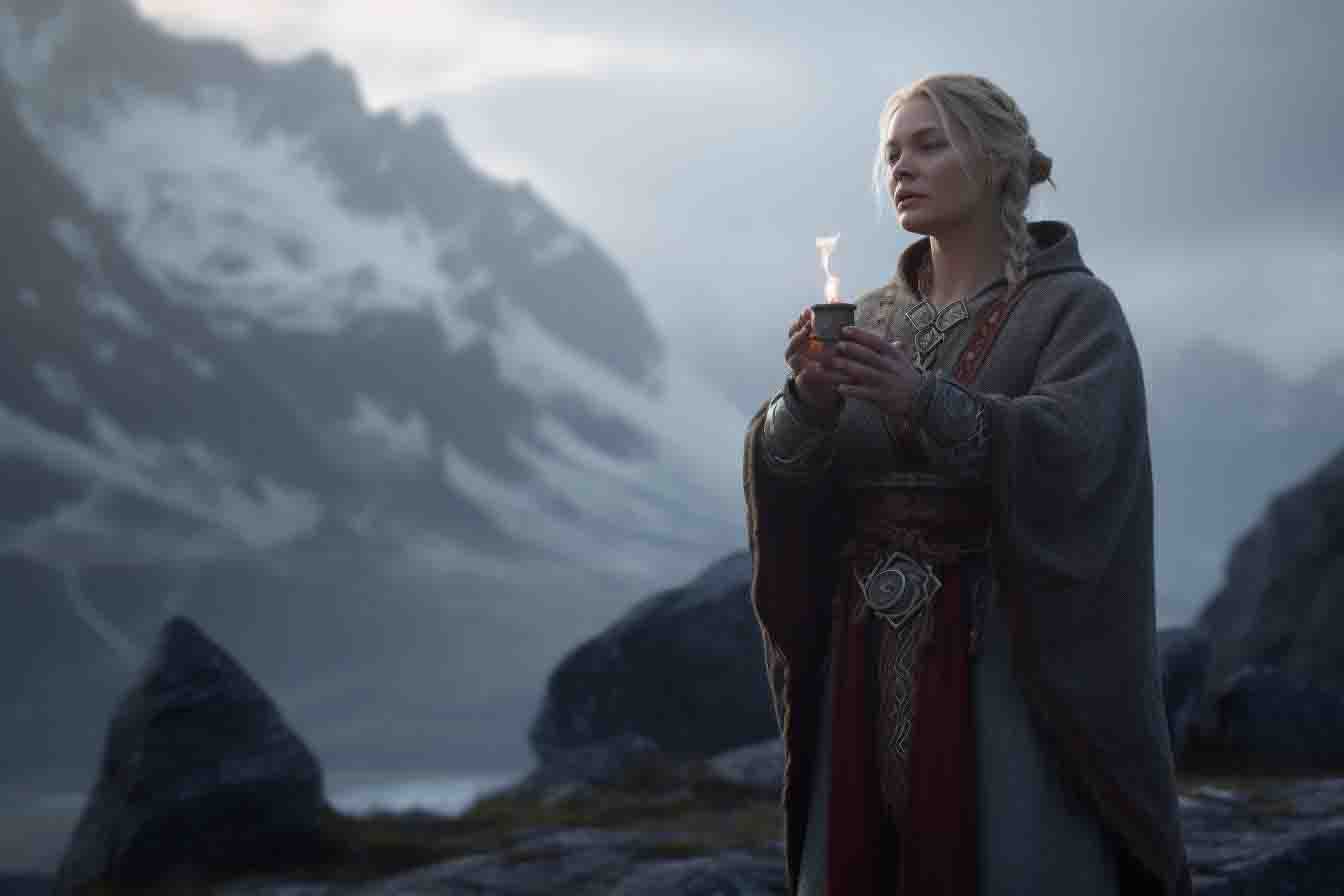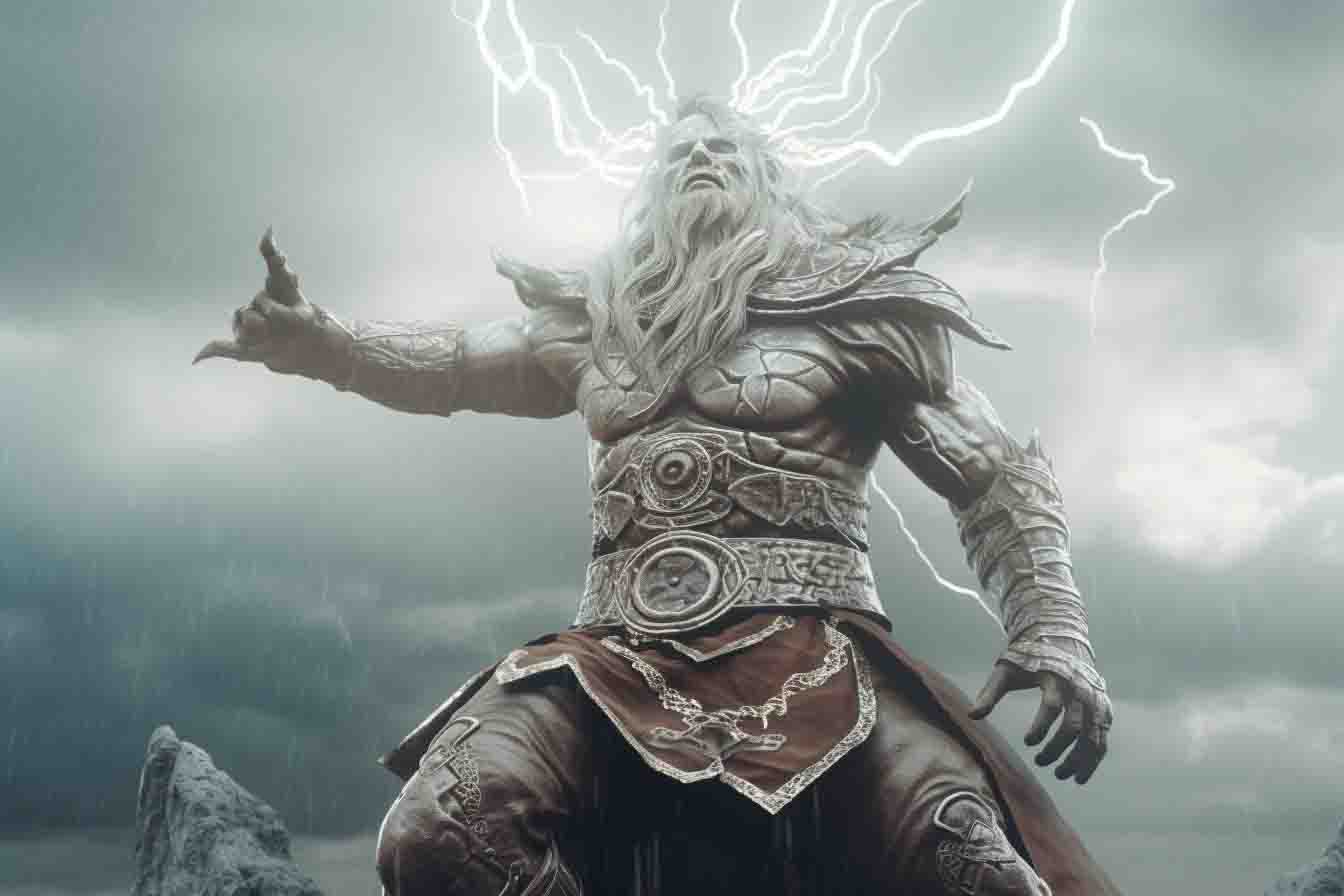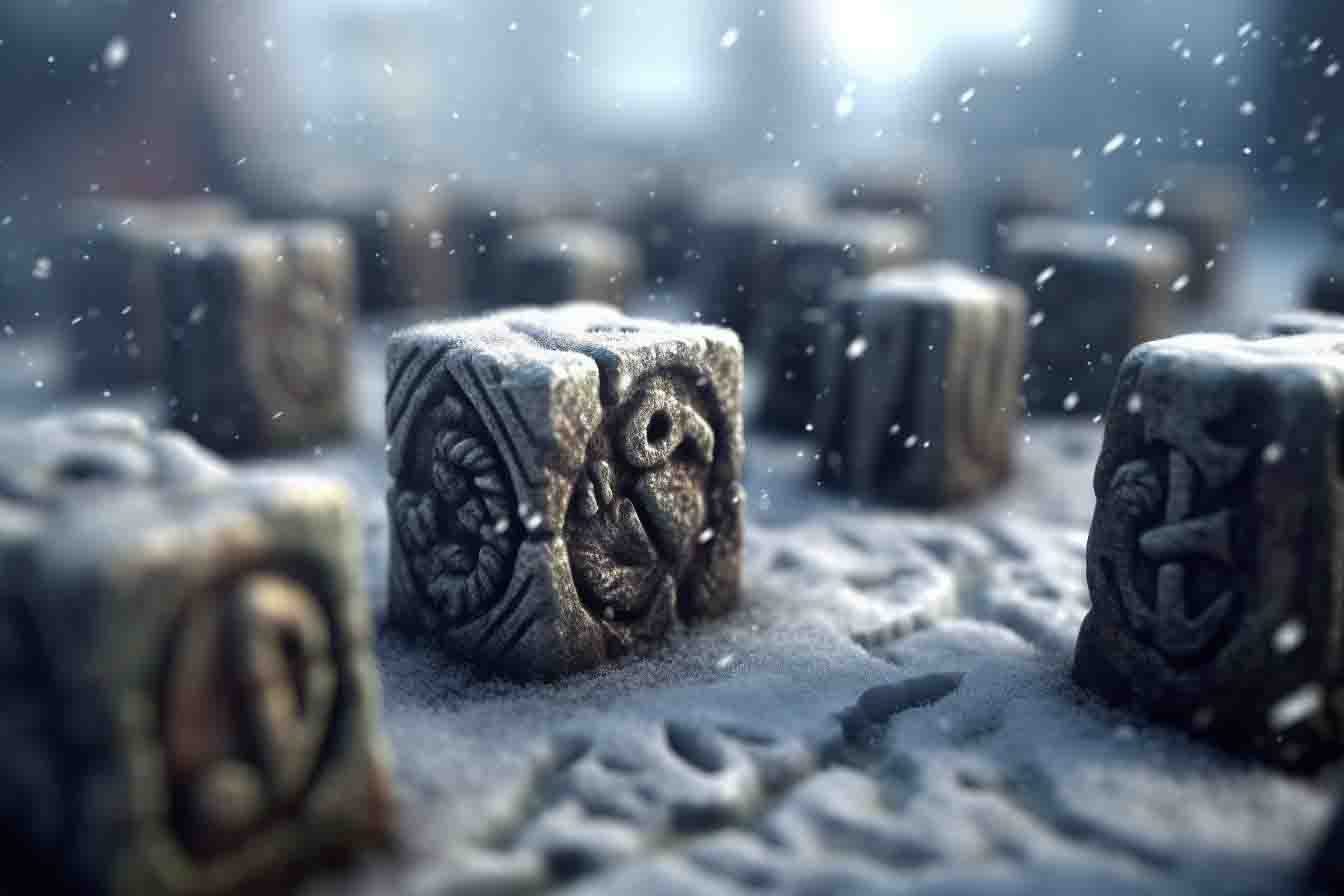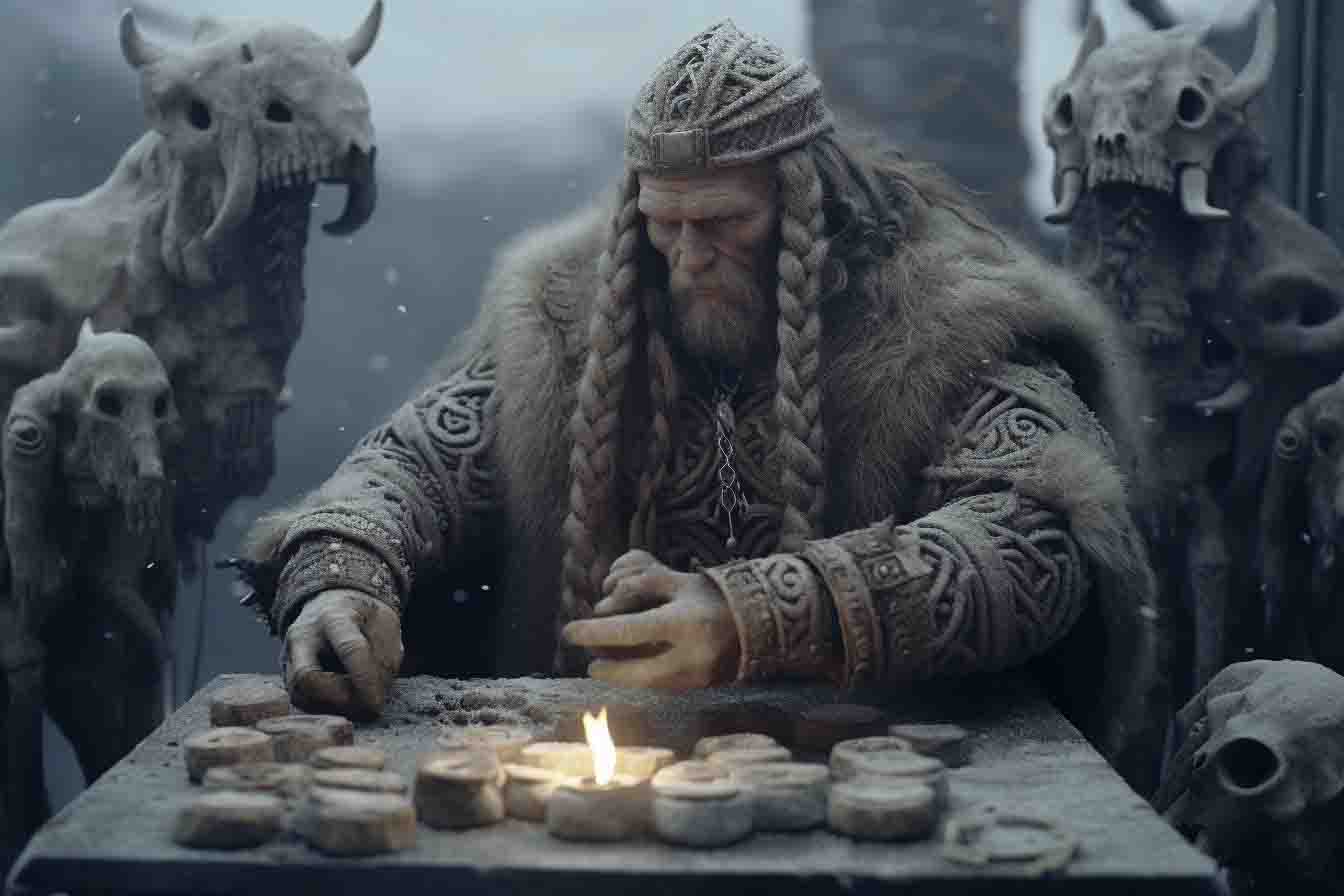Overview
Farang Paganism, also known as
North Old Faith, is a diverse and decentralized spiritual tradition originating in the High Northern regions of
Arlok. Known for its adaptability and resilience, it has met the spiritual needs of the northern peoples for thousands of years, surviving even the advent of the
Läänti Ascendist branch of the
Congregation of the Ascended. Its existence dates back to the
Roll of Great Capelin, as per the oral history of the
Band of Reeds tribes, making it about 4,000 years old. Despite its lack of centralization and formal texts, the faith is deeply embedded in the cultural customs, practices, and shared stories of the people.

by midjourney
Oral Tradition and Storytelling
Through a rich oral tradition, epic tales of heroes, gods, and ancestors are passed down from generation to generation. These stories serve as moral and cultural guidelines for the community, preserving ancient wisdom and nurturing communal values.
Beliefs and Deities
The central belief of Farang Paganism is the sacredness of the natural world, with the mountains, rivers, and forests seen as living entities, each home to its own spirit or deity. The three greatest of these include
Dwergru, the God of Stone and Echoes, embodying the harsh and resilient mountains;
Mairwren, the Goddess of Snow and Silence, personifying the vast, serene snowscapes; and
Harrogon, the Thunderbringer, embodying the raw power and unpredictability of the weather. Outside of these exist
Veridessa, the Goddess of
Dawn and Prophecy;
Yggvith, Whisperer of Secrets;
Geirrun, God of Time;
Skaldor, a Trickster Goddess;
Myrkul the Traveller;
Galdr, the Weaver of Fate;
Veldi, a forest god and many others.

by midjourney
Above: Harrogon the Thunderbringer
Religious Festivals and Observances
Religious observances range from personal devotions performed in private to grand festivals celebrated by entire communities. The annual celebration of the
Winter's Embrace is the most significant, marking the arrival of winter's longest night and celebrated with feasts, sacrifices, and communal storytelling. Each deity also has its own feast day, observed by individuals and clans who hold that deity as a personal or clan patron.

by midjourney
Above: Holy statuettes in a household shrine.
Sacrifice and Divination
Sacrifice plays a significant role in Farang Paganism, ranging from simple offerings of food and trinkets to the spirits of a household or clan, to grand, communal sacrifices of livestock during major festivals or times of crisis. Among the
Kingga people of
Farakt, the hunting of the
Tväs is both a rite of passage and a form of tribute to the mountain gods; those who lose their lives to these beasts are envied as it is believed that Mairwren herself liberates their souls. Other than this example, direct human sacrifice in the name of the gods are rare, but not unheard of.
Followers of Farang Paganism also practice divination, seeking guidance and predictions from the natural world. They throw runes, made from bone or stone, and interpret their patterns to divine the future or seek advice. They also observe the movement and behavior of animals, cloud formations, and the change of seasons as signals from the deities. This practice is said to precede the emergence of
The Seers, Arlok's first known tradition of magic.

by midjourney
The Seers of Ama-Toh
The
Lair of the Seers on frosty
Lake Ama-Toh in
Bimmentok is an ancient institution revered across the High North, a cornerstone of the spiritual life of pagan tribes, predating
The Aurimbic Tradition by more than a milennium. In contrast with folk diviners, Seers are able to see the future truly and clearly, but they do not begrudge the common people their practices or beliefs, however ineffective they ultimately might be. Far from it: many of the structures within the Seers' own tradition derive from earlier pagan "magic", and its members are deeply religious, offering prayers and sacrifices to the same old gods worshipped by other northeners in the course of their rituals. The two sides of this equation live in perfect harmony, each complimenting more than contradicting the other.
The relationship with the Aurimbics, however, is more fraught and complex.
Council Magic and Hedge Wizardry
The advent of the
Aurimbic Tradition in
UT 2450 brought a new dimension to the spiritual landscape of Farang Paganism. This tradition, originating with the birth of
The Madman, Keldaroth, marked a divergence from the Seers, and as the centuries have unfolded, the rift between the two groups has only deepened.
The Seers' main gripe regards the nature of their gift, called '
the Sight', which they sternly deny is magic; instead they hold it to be a natural force some are fortunate enough to be privy to. A Seer's visions come unbidden into the mind, and are seen as a communication from the gods. Aurimbics, by contrast, learn to manipulate this ability for themselves, zooming in and out of Fate's
grand architecture to get a grip on its structure and theorize how it works, all of which is seen as ungrateful and meddling behaviour by the Seers, squared against the Sight's divine origin.
Though Aurimbics resisted joining
The Council of Landezon for a long time, they finally did so during the early years of the
Drakoyan Old Empire (1501-1212), an act worsening relations with the Seers, who have no love of
Relan powers. Despite ideological differences, both groups tended to approach matters mostly pragmatically and collaborated as needed, as they continue to today, each acknowledging the other as an integrated part of northern culture. While Aurimbic monks have no formal stance on religion per se, the fact is most
Strongholds they oversee dot the south of
Arlok, where
Läänti Ascendism is stronger than the paganism of the High North. So from the Seers' point of view, their Aurimbic brethren are under the thumb of not one but two Relan institutions, and perhaps three, if one counts their allegiance to the nobles of the land, whose ties to
Draksineon are inevitable.

by midjourney
There is also a fringe group of hedge wizards operating in the High North, loosely associated with paganism and outside the jurisdiction or monitoring ability of the Council. These individuals tap into the ambient magic that grows stronger the further north one goes, and some are thought to have potential connections to the legendary magical community of
Fireside, assuming it exists. The names or forms of their specific traditions are unknown to the Council, as such wizards are highly secretive, and live far outside settled areas.
Impact on Daily Life
Farang Paganism permeates every aspect of daily life, from food gathering and hunting rituals to the tattoos each person proudly wears, often signifying their clan or the gods they venerate most. The grand hunt of the Tväs, for instance, is not just a quest for food or sport but a deeply spiritual journey that tests the mettle of the hunters and honours the mountain gods. Bravery, strength, and endurance, are core virtues cultivated daily, as built upon personal accomplishments, clan legends, and deep faith.
Conflict and Coexistence with Läänti Ascendism
Farang Paganism and
Läänti Ascendism have a complex relationship, marked by conflict and coexistence. The adoption of Läänti Ascendism during the reign of Eannelk emperor
Bodur the Elder (
UT 652) was seen as a foreign imposition, and many northern tribes resisted its influence. Despite this resistance, Läänti Ascendism has gained followers among the urban centers and those with closer ties to the south.
Generally speaking, Farang Paganism remains the most vital force in the remotest regions of Arlok, where the sphere of Läänti Ascendist control remains weak. The faith's flexibility, decentralization, and roots in the harsh realities of life in the Far North continue to resonate with the northern peoples, ensuring its survival and growth in the face of changing religious landscapes.
Modern Interpretations and Practice
While many continue to follow the old ways, modern interpretations of Farang Paganism have also emerged, reflecting the evolving understanding and needs of its followers. Some groups have reinterpreted the lore and rituals in light of contemporary issues, while others maintain a more traditionalist approach.
Regardless of the variety of practices and beliefs, Farang Paganism's core tenets remain unaltered – reverence for the natural world, a deep connection with the spirits and deities that inhabit it, and the significance of community and shared stories. Despite the challenges and changes over the centuries, the Old Faith continues to thrive and adapt, a living testament to the enduring spiritual resilience of the northern peoples.








Comments